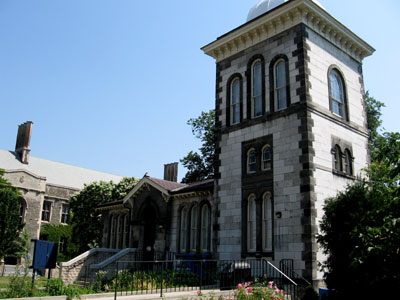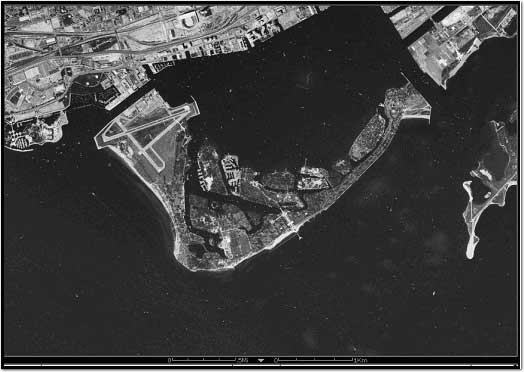My summery biking adventures through Toronto continue. This morning I packed my backpack and as usual I entered the Taylor Creek Park system. Heading down into the lush green river valley that is fully closed in by trees and bushes on both sides is always such a great feeling, as if the big city was miles away. Yet, I was riding right in the middle of East Toronto, in the heart of Canada’s biggest population centre.

Exploring the ravine systems of Toronto by bicycle
A few kilometers west my trail joined up with the Don Valley biking trail and I started to ride south. But instead of heading all the way down to Toronto’s lakefront, I saw an old road branching off to the right north of Pottery Road and I thought I would just ride in there and see what I could discover. I had never before left the main trail and was curious to explore this new area. Actually, I thought I would arrive at the Don Valley Brickworks, the leftovers of an industrial brick making complex dating back to the late 1880s that was closed down some time ago. The bricks from this quarry were used on many famous Toronto landmarks, including Casa Loma, Osgoode Hall and Queens Park (the Ontario Legislature building). The green space surrounding the empty buildings has been turned into a public park by the city.

Serene walking trails
But as I continued the road turned into a narrow pathway that crossed a field and the path started taking me in a northwesterly direction, away from the Brickworks. Now I was really wondering where this path was going to lead. After crossing some more meadows the path took me into a forested area where the narrow trail continued, sometimes over roots and stones, sometimes beside some railway tracks. Now you might think that it could be quite dangerous for a woman by herself riding these trails, but I actually felt quite safe. The only people I encountered were a father and daughter team who were enjoying their own little mountain bike adventure.

Views of the Don Valley
I kept riding through the forest, up and down and at some point I saw a road just above the embankment that I was cycling beside, but my suspense grew as to where I would actually end up. Finally I saw an opening in a fence at the edge of the forest and I realized I had popped up at the southeastern end of the Loblaws Supermarket in Leaside. This was quite a bit further north than I had anticipated.

Church in Leaside
So back on city streets I decided to ride through the residential area of Leaside, one of the most popular residential areas in Toronto. Settled as early as the beginning of the 19th century by the Lea family, the Town of Leaside came into being in 1913. Today many houses from the early 20th century remain and are being renovated or expanded. Leaside has become particularly popular with real estate investors who buy some of the small single story bungalows and convert them into two or three story mansions.

Florence Moosengale has joined the Tour de France
Bayview Avenue marks the western boundary of Leaside and is a popular entertainment area with lots of retail stores, cafes and restaurants. I cycled south on Bayview to the Intersection of Moore Avenue where there is a local landmark: a concrete moose that is located in front of a company called IntegraCare, a private nursing company.
From April to October of 2000, the City of Toronto was graced by 172 moose sculptures that were located all over the city and painted and decorated by local artists. The event was called “Moose in the City” and similar in idea to other animal sculpture campaigns in places such as Chicago, Mexico City etc. After the completion of the campaign the moose were auctioned off for charitable purposes and more than 75 local charities benefit from this unique fundraising idea. Events like “Toronto’s Running of the Moose!” and “Moose Jam on City Streets” enlivened the campaign and entertained the public.

Western entrance to the Mount Pleasant Cemetery
I figured Integracare must have purchased one of these moose sculptures and after doing some research on the Internet I found out that the moose’s name is “Florence Moosengale, RM (Registered Moose)”, her name obviously inspired by Florence Nightingale, the founder of modern nursing. Three Integracare employees regularly create new costumes for the moose which has been dressed up as Santa Clause, a witch for Halloween, a pink Easter Bunny, a prison inmate, a lady bug, and in many other outfits. Currently Florence is dressed up as a rider in the Tour de France, complete with a yellow jersey and an oversized bicycle.

Memorial to Steve Stavro, former owner of the Toronto Maple Leafs
Well, this moose always makes me chuckle and I truly applaud the efforts of the three ladies at Integracare in brightening up the intersection of Bayview and Moore Avenue. From here I rode into the Mount Pleasant Cemetery, Toronto’s largest cemetery which stretches from Bayview Avenue in the east to Yonge Street in the west. Originally conceived in 1873, the cemetery opening in late 1876 and became the final resting place for more than 160,000 Toronto citizens.

Mount Pleasant Cemetery
The cemetery holds many local celebrities, including Frederick Banting – the co-discoverer of insulin, Timothy Eaton – a Canadian department store magnate, Hart Massey – a 19th century tycoon in the farm equipment business, Robert Simpson – another Canadian department store magnate, pianist Glenn Gould and W. Garfield Weston, a business magnate and member of one of Canada’s most wealthy families. By accident I came across the grave of William Lyon Mackenzie King, one of Canada’s longest-serving and most influential prime ministers.

William Lyon Mackenzie King, one of Canada’s most influential prime ministers




